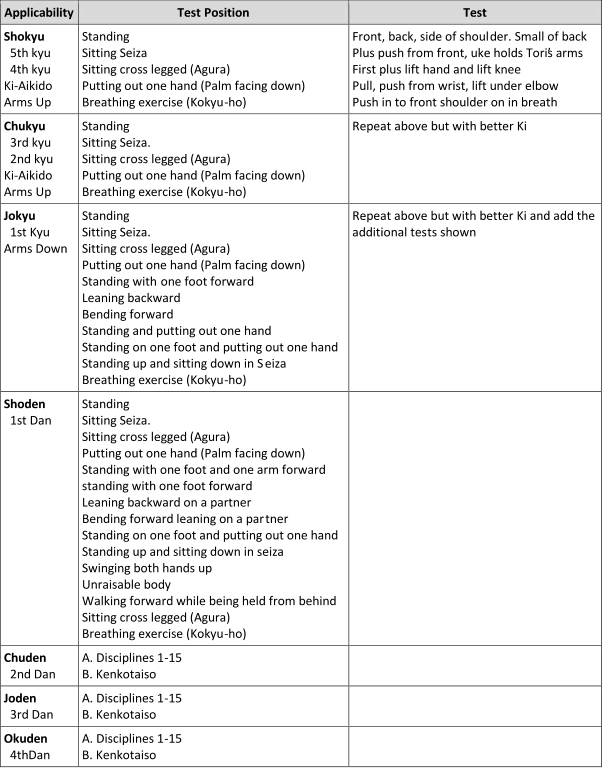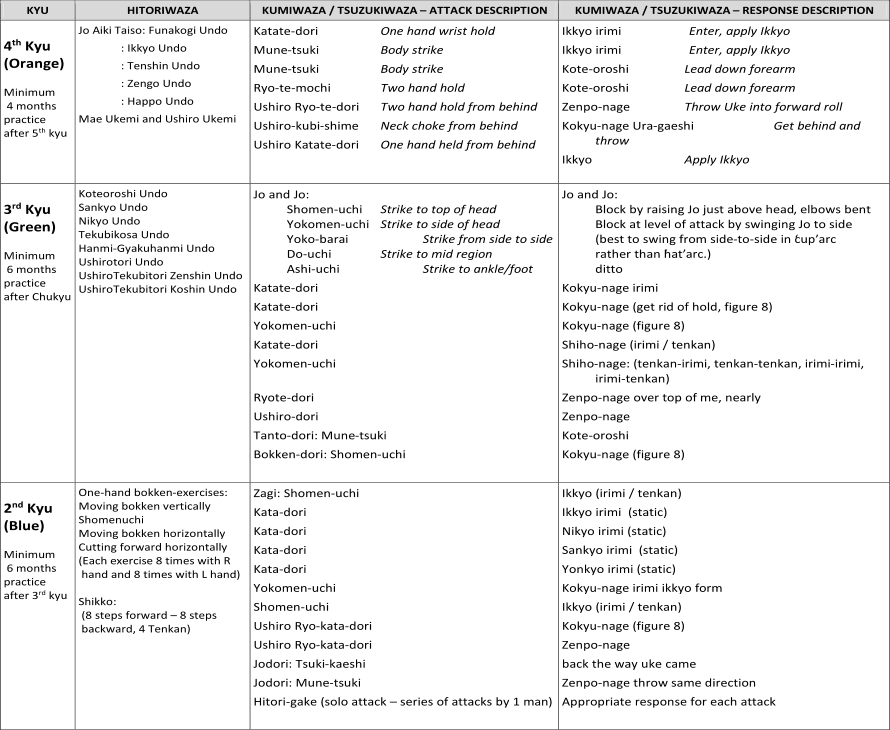

© Malcolm 2022

Ki Aikido Grading Information
Minimum Required Practise
In addition to the calendar intervals, a minimum number of practise hours should be completed. For a 4 month interval, at least 48 training hours should
have been completed and for a 6 month interval 72 training hours should have been completed.
Note:
This information applies to the British Ki Society (BKS) grading guidelines. The requirements do vary for other forms of Aikido that fall under different
governing bodies.
KI EXAMINATION
Begin with warm-up - Kenkotaiso (Health exercise). This is a part of the test. Chukyu – Examinee must do Kenkotaiso in the correct order Jokyu – Examinee must keep timing and rhythm with examiners count Shoden/Joden/Chuden/Okuden – Examinee must count with the correct rhythm Kenkotaiso (Health Exercise) (see the Exercises page for fuller description) 1. Turning the trunk clockwise and anticlockwise by rotating the shoulders with arms raised above the head 2. Stretching the trunk to the side by swinging alternate arms above the head 3. Stretching backward and forward by swinging the arms between the legs then above the head 4. Shoulder blade exercise 5. Moving the head down and up 6. Turning the head side to side 7. Bending at the knees and standing on tiptoe 8. Stretching the knee on alternate sides 9. Circling both arms while bending the knees 10. Shake out the hands; downwards, to the side of the body The Kenkotaiso is followed by the Ki tests. The Deshi adopts the pose described below applicable to their grade level. Sensei will test by gradually applying pressure, back, front, sideways, up and down as appropriate. Some checks (higher grades) require initial ‘bounce’ of pressure before full pressure is applied to test if the Deshi is able to maintain Ki despite being distracted. Succeeding levels require greater levels of Ki to be demonstrated.KI TEST
Chukyu – Examinee must do Kenkotaiso in the correct order Jokyu – Examinee must keep timing and rhythm with examiners count Shoden/Joden/Chuden/Okuden – Examinee must count with the correct rhythm
Aikido Examination - Kyu Grades

More Detailed Explanation for 5th Kyu:
1. Katate kosa-dori / kokyu-nage – Tori steps in behind Uke, bringing hand not being held onto neck, held hand brings Uke round, held hand drops bringing Uke forward slightly and comes back up over Uke’s face, hands extended with ki being laid over Uke as he drops to floor. 2. Katate-dori Ryo-te-mochi / Tenkan Kokyu-nage – free hand extends outwards to bring Uke off balance, then as for ‘1’ above. 3. Katate-dori / Tenkan Kokyu-nage – Tori steps in beside Uke (not disturbing the hold) and turns both palms to face up (tenkan); walk Uke round in circle (Tori on inside & not too tight or Uke may let go). Bend both knees, so down, up and extend hands laying ki. Uke falls. 4. Katate-dori Ryo-te-mochi / Tenkan Kokyu-nage Ude-mawashi – Tori brings body in to Uke, folds held arm close into body with hand in ‘beak’ position in shoulder, walk Uke in circle, circle ‘beak’ arm down and round (ude-mawashi – sweep of the arm) bringing Uke through 180 turn, kokyu-nage. 5. Zagi Ryo-te-dori / Kokyu-nage irimi – one hand turns over Uke’s hand bringing it to floor with Uke forward and off balance, other hand goes up to shoulder height and takes Uke backwards until Uke rolls on back, move outer knee in to maintain balance. Sit on heels (which should be together) but with toes still tucked under. Hold, as Uke will test Tori’s ki in this position. Note: Different techniques are employed by different Sensei. For example in ‘1’ above, one advocates walking the uke round in a circle whereas the others simply turn the uke through 180 before dropping the hand. Different emphasis is put on the held hand too. Different styles is not necessarily a bad thing as in real life each attacker and each attack varies – but it does make it more difficult to learn.
Note:
Hitori-waza – ‘alone techniques’ – ie practising by one’s self – solo techniques
Kumi-waza – ‘couple techniques’ – ie two people practising together
Tsuzuki-waza – ‘continuity techniques’ ie techniques woven together one after another
Note. ‘Figure eight’ does not refer to an English Figure of 8. See definition of Hasso No Kamae, which reads: The figure eight does not correspond to the Arabic
numeral "8", but to the Chinese/Japanese character which looks more like the roof of a house. In Hasso No Kamae, the sword is held up beside one's head, so
that the elbows spread down and out from the sword in a pattern resembling this figure-eight character.






















